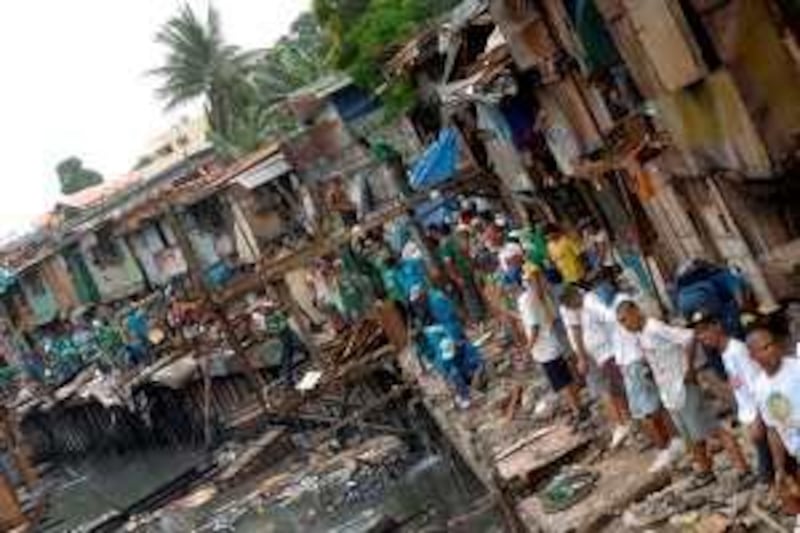MANILA // Egardo Bantayan surveys the tiny room he and his four children now call home and shakes his head in despair. Everything he and his family owned was washed away in the deluge that drowned Metro Manila on September 26.
Binhi ni Abraham, the squatter area where he and his family lived in Quezon City, is now just a memory. A sea of brown, swirling water obliterated it during the height of Tropical Storm Ketsana. "Nothing is left. The whole village is gone," he said, standing in a narrow, dirty alley that divides the makeshift shacks. Inside, what few things they have collected - an old pot, a pan and bedding - are all they have. Even their clothes are second-hand.
Mr Bantayan, 56, and his family moved to a temporary resettlement camp in Bagong Silangan, an area that has sweeping views of the Marikina Valley, north of Manila. "We have been told we can stay here for a month, then after that we don't know. No one has told us anything." His son Matranil, 22, is still traumatised by the flooding. "It was like a nightmare. So much water," he said. "We managed to get out with our lives. I still can't believe it. I just hung on to my younger siblings."
Mr Bantayan and his family are among 60 others from Binhi ni Abraham now living in shelters made from scrap wood and tin sheeting. The local authorities have barred them from going back to rebuild along the waterway they once called home. But where they will go no one knows. Thousands of squatters around Metro Manila, especially those living on canals and waterways, face an uncertain future. About 70,000 squatter families - translating to an estimated 350,000 people - live on or around Manila's waterways, according to Bayani Fernando, the chairman of the Metropolitan Manila Development Authority.
Rubbish from the squatters has been blamed for causing much of the flooding, which left nearly 80 per cent of Metro Manila under water when Ketsana dumped 117mm - more than a month's rain - in just six hours. Over the years, Manila has become a magnet for thousands of people from the provinces seeking a better life. Most of them end up in squalid squatter camps where they eke out an existence in whatever menial work they can find.
According to Mr Fernando, there are three million squatters living in Metro Manila, a metropolis he says now has close to 14 million people, and the number is growing. Wearing a blue shirt, jeans and mud-spattered boots, he said: "One thing this disaster has done is highlight the fact that we have to reassess our relocation policy for these squatters. Placing them in resettlement areas outside Manila and on flood plains is not the answer.
"There are no jobs, no markets - nothing. So they drift back to the squatter areas. We need to relocate in-city with government housing projects - similar to Hong Kong." Mr Fernando said the squatters living on waterways and canals should not shoulder all the blame for the flooding. He said Manila's uncontrolled urban sprawl had a hand in creating the disaster. The Marikina Valley that bore the brunt of the flooding was once covered in rice paddies. Today nearly 70 per cent of the valley is housing and most of it on flood plains, he said.
Along Laguna de Bay more than one million people live on the shoreline, many of them squatters, according to Edgardo Manda, director of the Laguna Lake Development Authority. He said many of the squatters live on wetlands and block vital waterways with mounds of rubbish that have built up over the years. In Malibay, in Pasay City, Bernard Pierquin has run the Alouette Foundations for more than 20 years in a slum known as E Rodriguez.
"Nothing changes here," he said. "People come and go. No one knows exactly how many people live here." He estimates about 3,000 families live in squalor. Many of them live along a canal that empties into a man-made lake that was build during the days of Ferdinand Marcos's dictatorship to collect run-off water from Manila. Today the canal and the lake are one big sewer and rubbish dump clogged by decades of indifference both by residents of the slum and local authorities alike.
Mr Pierquin lived in the slum for two years in the early 1990s when he first arrived to experience for himself what it was like to be poor - dirt poor - in Manila. "I can't tell you what it was like," he said. "You have to experience it yourself. Rats crawling over you as you tried to sleep, and the rain that poured in through the roof. During the day the sun would beat down on the tin roof of the shanty, making life inside unbearable.
"If you wanted to go to the toilet you just did it in the canal." He said attempts by successive governments to move squatters from Metro Manila to areas outside the capital had, by and large, failed. "People drift back to the city because they can get work," he said. Mr Fernando agreed, adding: "Many local residents are not happy having squatters relocated to their area. "In many cases squatters are not welcome by the local community. That is why our strategy has to change and look at in-city relocation. There is a lot of unused government and privately owned land and buildings that could be used to build medium density housing.
"It has worked in other cities in the region; why not here? It can be done. It just needs political will to make it happen and, yes, the money." foreign.desk@thenational.ae





